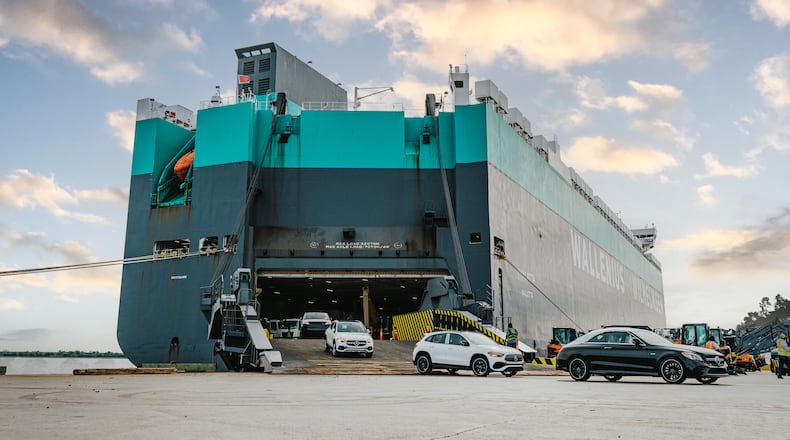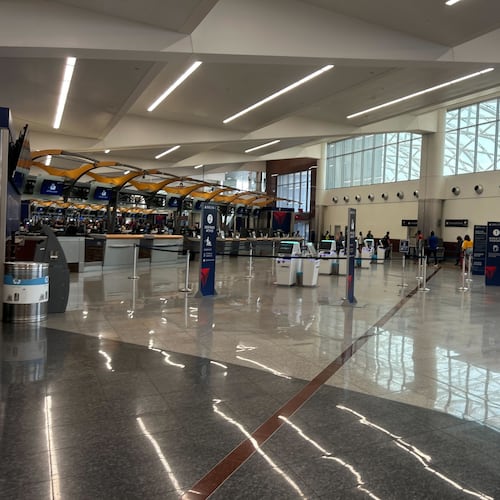BRUNSWICK ― For anyone who’s ever experienced the frustration of going to buy a new car only to be told the dealer doesn’t have the vehicle in stock, there’s cruel irony in a visit to the Georgia Ports Authority’s automobile terminal.
Row upon row of new cars, in dozens of makes and models, crowd the concrete lots of the 1,700-acre facility on Colonel’s Island, located across the Turtle River from Brunswick’s sleepy-yet-charming downtown. More than 800,000 BMWs, Mercedes-Benzes, Hyundais, Nissans and Chevys — along with cars from 18 other automakers — will have passed through the port this fiscal year, which runs through June 30, making Brunswick the second-busiest auto terminal in the United States.
Brunswick will take over the top spot, due in part to the ongoing shutdown of its main East Coast rival, the Port of Baltimore. That terminal has been inaccessible since March 26 when a cargo ship lost power and steerage and struck the Francis Scott Key Bridge, causing a collapse that blocked the shipping channel and killed six maintenance workers.
Baltimore-bound ships that also call on Brunswick have offloaded more automobiles, farm implements and construction equipment at Colonel’s Island since the accident. Of the record 80,600 units handled at Brunswick in April, about 10,000 were supposed to go through Baltimore. Those additional vehicles turned what would have been a “top-10 month” for Brunswick into the terminal’s busiest ever.
Even as salvage crews work to clear wreckage from the Baltimore shipping channel — the gateway is projected to reopen by the end of May — Georgia Ports Authority officials are more confident than ever that Brunswick will surpass Baltimore in auto cargo volume within the next two fiscal years.
“We have a unique asset that we’ve been able to grow because of the service we provide,” Ports Authority President and CEO Griff Lynch said. “Brunswick is well-situated geographically, and the terminal is scalable and expandable, unlike most other ports, including Baltimore.”
‘You can’t stack cars’
Brunswick’s ascendence is part of a decades-long strategy meant to maximize efficiencies across the Georgia Ports Authority’s terminals along the coast.
Officials long ago recognized how facilities in Savannah and Brunswick complemented each other in terms of geography and logistics.
Credit: Katelyn Myrick
Credit: Katelyn Myrick
Savannah, the westernmost port on the Atlantic seaboard, is a rail and highway epicenter, perfect for container cargo. Brunswick, located 80 miles to the south, has ample acreage and a location in an uncongested area less than three miles from an Interstate 95 interchange. Colonel’s Island is the rare terminal where it made financial sense to target vehicle cargo business.
“You can’t stack cars like you do containers,” said Flavio Batista, who courts business for Brunswick as the Port Authority’s vice president of sales and marketing. “You need lots of land, and you have to be committed to (vehicle cargo) for the long term.”
Containers are conspicuously absent at Colonel’s Island, as are the hulking, container-lifting cranes that stand like sentries along the Savannah waterfront. In Brunswick, wheeled and tracked vehicles of every type and color, along with mammoth, shroud-covered pieces of equipment on flatbeds, dot the docks and yards.
Three ship berths front the terminal, and bidding for construction of a fourth dock begins in June. Inland from the waterfront, four auto processors manage the import and export of autos.
One of the largest, Norwegian shipping company Wallenius Wilhelmsen, signed a 20-year lease extension in April and will develop an additional 130 acres to grow its footprint. The expansion will boost Colonel’s Island’s total capacity to 1.4 million units — with another 300 undeveloped acres remaining at Colonel’s Island.
According to Batista, interest is high. Ports that specialize in vehicle cargo are rare, and with the Sun Belt’s population growth and the surge in auto manufacturing in the South in recent decades, Brunswick is in a “sweet spot” for both imports and exports.
As Savannah-based ports and trade consultant Walter Kemmsies summarizes, Brunswick offers automakers the “three Cs” of maritime shipping: cost, consistency and capacity.
“If you locate your business there you should be able to get the job done and not worry about shortcomings found elsewhere,” he said. “It’s cost effective, the service is consistent and it has the capacity to serve you when you look to increase your business. That’s not the case in many other places.”
Credit: Katelyn Myrick
Credit: Katelyn Myrick
The Georgia Ports Authority’s consolidation of its wheeled and tracked vehicle operations in Brunswick is nearing completion. The authority previously handled tens of thousands of autos and the like at Ocean Terminal in Savannah, giving shippers a second option. But Ocean Terminal is being converted to a container-only facility, with extensive construction now underway.
The Savannah facility is in a dense urban area with little yard acreage, and while auto-carrying trailers can access the interstate just outside the gate, many trucking companies have told the Port Authority they prefer working out of Brunswick.
“With the size and scope of our operations, Brunswick is an exceptional location, where we can provide all of our core services — ocean and inland transportation, vehicle and equipment processing, and terminal services,” said Mike Hynekamp, chief operating officer of Wallenius Wilhelmsen.
Credit: Georgia Ports Authority
Credit: Georgia Ports Authority
Consolidation and synchronization
Once a ship ties to the Colonel’s Island dock, activity on the terminal quickly starts to resemble that of an ant colony.
The boxy vessels are essentially floating parking lots, carrying anywhere from 2,000 to 7,000 vehicles in their holds. Their cargo rolls off in almost synchronized precision. The autos go directly to the processor facilities spread across the property while the rest of the wheeled and tracked cargo move to a yard adjacent to the ship berths.
The process then works in reverse for export cargo.
The auto processing firms — Wallenius Wilhelmsen and International Auto Processing along with automaker facilities for BMW and Mercedes-Benz — act as more than storage yards for the cars and trucks. Many of the vehicles’ finishing touches, such as installation of stereos, mirrors, floor mats and spoilers, happen here, not at the factory or dealership. Processors also inspect cars for minor flaws and make repairs on-site.
The auto processors stage vehicles for export for 10 to 15 days on average and is home to imports for up to three months. The length of stay is market driven, the Ports Authority’s Batista said.
Supplying cars in a hot market has always been an advantage for Brunswick’s chief East Coast rival, Baltimore. The port’s location in the Northeast corridor means it can quickly feed vehicles to dealers in the New York/New Jersey area, New England and the mid-Atlantic states and export autos produced in the Rust Belt of Ohio, Michigan, Indiana and Illinois.
Yet Georgia Ports Authority officials are anticipating accelerated growth, as longtime Baltimore clients forced to do additional business through Brunswick in recent months have come to appreciate Colonel’s Island’s efficiencies.
“The Baltimore business we did here will go back to Baltimore once the port reopens,” Lynch said, “but we were growing here before and that’s because space is the key.”
About the Author
Keep Reading
The Latest
Featured






